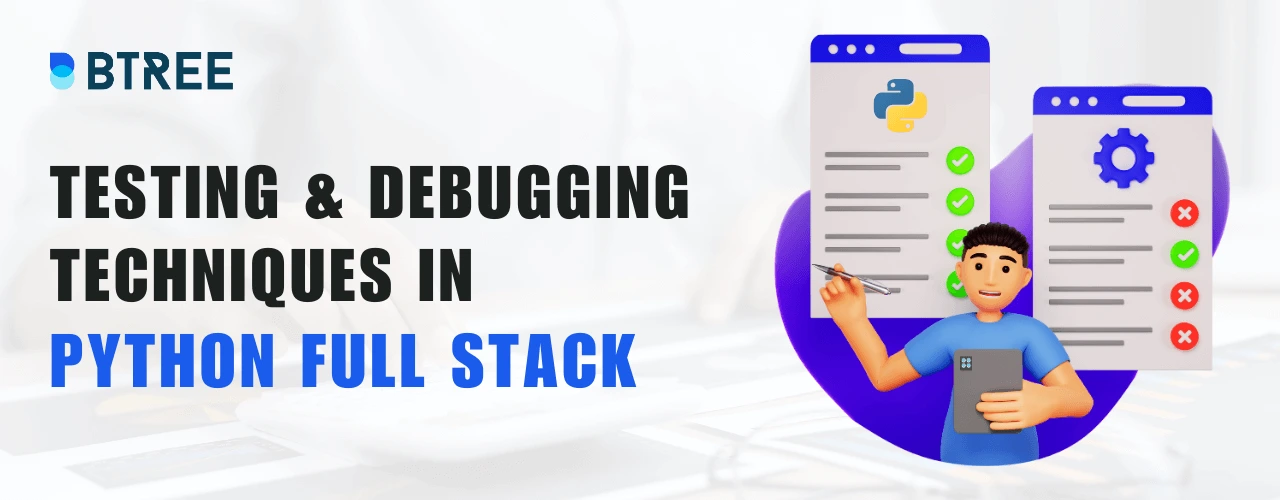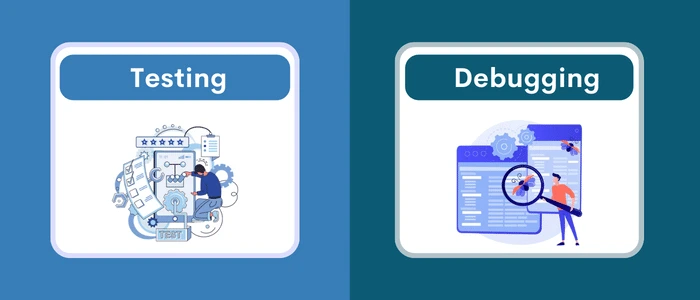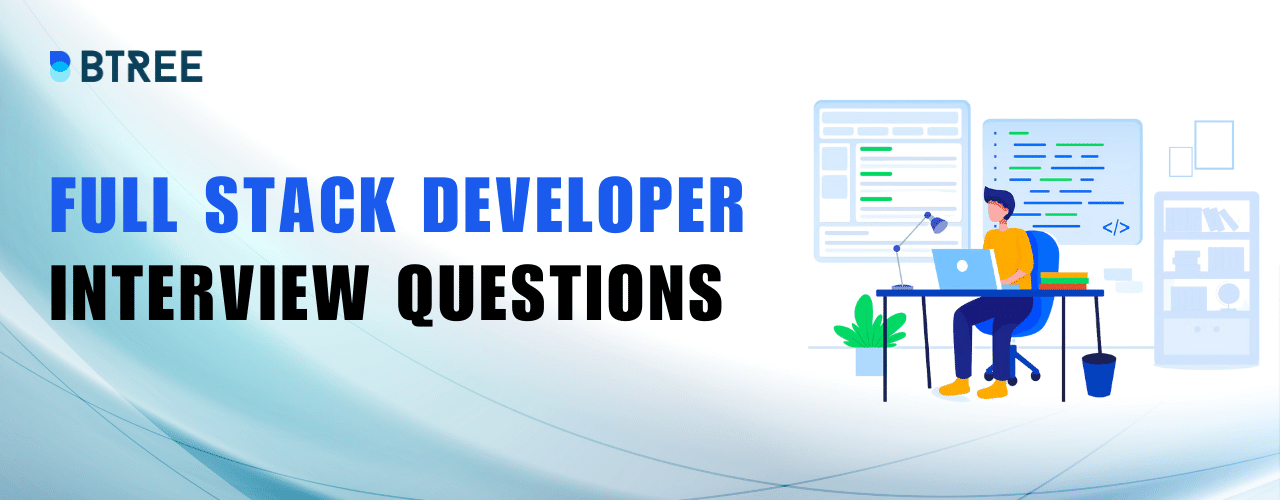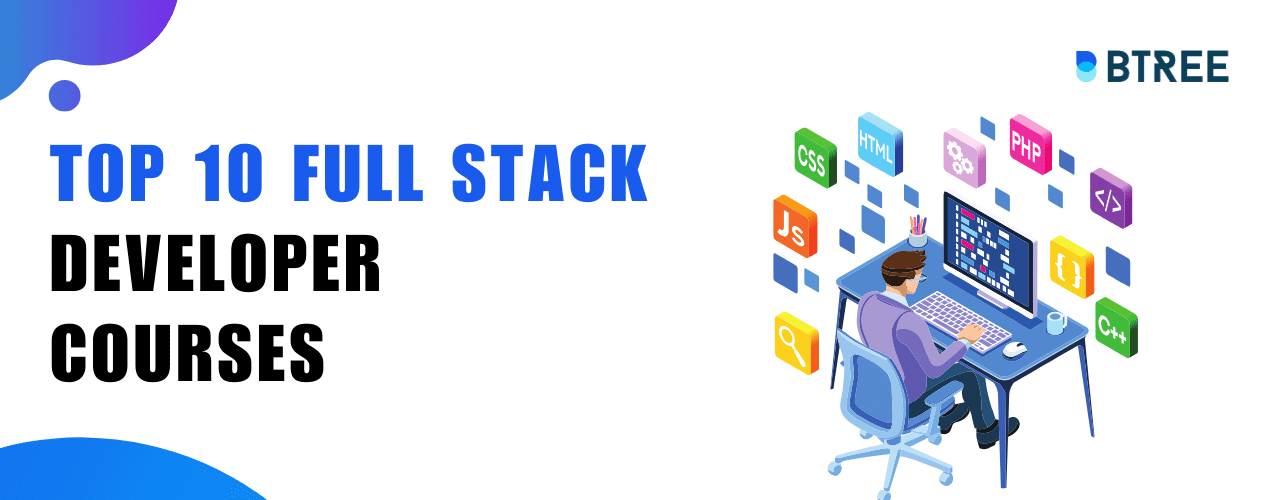
- Importance of Python Full Stack Testing and Debugging
- Testing Techniques for Python Full Stack Developers
- Debugging Techniques for Python Full Stack Developers
- Best Practices for Testing and Debugging in Python Full Stack Development
- Common Challenges in Testing and Debugging for Python Full Stack Development
- Conclusion
- FAQs
Importance of Python Full Stack Testing and Debugging
Testing and Debugging are the two most powerful elements that take your software development game to a next level, especially in Python Full Stack Development. They are essential to deliver a top-notch quality and highly reliable software system. Let's look at how much importance to holds in Python full stack testing and debugging techniques.
a. Ensuring Software Quality
One of the primary dreams of testing and debugging techniques is to ensure software quality. By thoroughly testing the application, developers can confirm that it functions as intended and meets the required necessities. Testing helps identify deviations from expected behavior, permitting developers to restore issues and enhance the quality of the software. This guarantees that the software performs reliably and consistently.
b. Detecting and Fixing Issues
Testing is a proactive method of figuring out bugs, mistakes, and troubles within the application. Developers can detect potential issues early in the development cycle by systematically trying out unique components, modules, and functionalities. This allows them to deal with those problems promptly and solve them before the application is deployed to manufacturing. Regular debugging similarly aids in identifying and resolving any unexpected troubles which may arise during the development or after deployment.
c. Enhancing User Experience
Python Full Stack Testing and debugging notably contribute to the general user experience of a Python full stack application. By detecting and resolving problems, developers can create an extra solid and reliable application, leading to a smoother user experience. Users want applications to work seamlessly, without any errors or unexpected behavior. Thorough testing allows for identifying and fixing issues that would negatively affect the user experience, ensuring higher user satisfaction and retention.
d. Maintaining Codebase Stability
As Python full stack applications evolve, the codebase undergoes adjustments and updates. These adjustments can invite new bugs or problems that disrupt the application's stability. Regular testing and debugging are essential for maintaining the stability of the codebase. Through complete testing, developers can catch and address any troubles arising from code modifications, ensuring the application remains solid and performs optimally.
Testing and debugging aren't one-time deals; they must be included in the development procedure at various stages. Developers can employ different testing techniques, which include unit trying out, integration trying out, functional checking out, performance testing, and protection testing, to thoroughly examine the software and ensure its reliability. Additionally, powerful debugging techniques, including logging, using debugging gear, engaging in code reviews, and implementing robust error and exception handling, can aid in identifying and resolving issues.
Testing Techniques for Python Full Stack Developers
Python full stack developers use diverse testing techniques to ensure the quality and reliability of their applications. Let's explore some of the vital testing strategies utilized in Python full stack development:
a. Unit Testing
Unit testing is a vital method that focuses on separately testing individual parts or components of code. It allows developers to check if each part of the code is working correctly individually before combining them. Unit checks verify the correctness and capability of these devices by testing them in opposition to specific inputs and anticipated outputs. Python offers frameworks like Unittest and Pytest, which give solid tools and assertions for creating and executing unit tests. Unit checking out allows developers to catch bugs and errors early in the development process, allowing for quick identification and resolution.
b.Integration Testing
Integration testing examines the interaction and integration between distinct modules, components, or services within a full stack application. It guarantees that those elements work seamlessly together and communicate successfully. In Python full stack development, integration exams focus on testing the integration of back-end components, APIs, and front-end interfaces. Integration assessments include database connectivity, API endpoints, authentication, and user interface interactions. These tests assist in becoming aware of issues that arise from the collaboration of various elements of the application, such as data flow or any communication errors.
c. Functional Testing
Functional checking out verifies the conduct and capability of the application by testing its features and functionalities against predefined specs and necessities. This testing technique ensures that the application performs as expected from the user's perspective. Python gives frameworks like Selenium and PyTest-BDD, facilitating functional testing by automating consumer interactions and simulating real-life situations. Functional assessments cover consumer workflows, user interface validations, input validations, and error handling. They assist in making sure that the application meets the functional requirements and offers a quality user experience.
d. Performance Testing
Performance trying out evaluates the application's responsiveness, scalability, and efficiency below specific workloads and pressure situations. Python full stack developers use overall performance testing to measure and analyze diverse overall performance components along with response time, throughput, reminiscence utilization, and CPU utilization. Tools like Locust and Apache JMeter assist in simulating high user loads and stress situations. Performance tests assist in identifying performance issues, enabling developers to optimize the application for high-quality performance.
e. Security Testing
Security testing is essential to assess the vulnerability of a Python full stack application to potential threats, including data breaches, injections, and unauthorized entries. Developers use security testing techniques to identify and mitigate safety risks and ensure proper security features are implemented. Security testing encompasses strategies like penetration testing, vulnerability scanning, and code reviews. By using security testing, developers can identify and fix protection vulnerabilities, protect sensitive user data, and shield the application from malicious attacks.
In Python full stack development, a combination of these testing techniques is frequently used to ensure comprehensive test coverage and validate the application's capability, overall performance, and security components. Additionally, test automation tools and frameworks, continuous integration and continuous deployment (CI/CD) pipelines and cloud-based testing platforms contribute to efficient and effective testing processes.
Using suitable testing techniques and tools, Python full stack developers can become aware of and deal with troubles early, enhance the application's quality, and deliver a dependable and robust application to stop-users.
eady to start developing some dope applications? Enroll in our Python Full Stack Development Course in Chennai today!
Debugging Techniques for Python Full Stack Developers
Debugging is a critical process in Python full stack development that allows developers to identify and resolve issues in their code. It includes investigating and fixing bugs, mistakes, and unexpected behavior to ensure the proper functioning of the application. Let's discover a number of the commonly used debugging techniques for Python full stack developers:
a. Logging
Logging is an effective debugging approach that includes putting log statements within the code to capture any specific information at runtime. Developers can use the logging module in Python to generate log messages at numerous levels of severity (debug, info, caution, blunders, and so on.). These logs can provide immense insights into the flow of the program, variable values, and any potential errors or exceptions. By studying the log output, developers can track the execution direction, identify problematic areas, and find the source of bugs.
b. Debugging Tools
Python provides numerous debugging tools that assist developers in understanding and resolving issues in their code. One famous debugger is the Python debugger, pdb. Debugging tools provide helpful features for developers. They let you pause your code at specific points (breakpoints), go step by step through the code, check the values of variables, and execute code line by line to find and fix issues interactively. Integrated development environments (IDEs) such as PyCharm, Visual Studio Code, and PyDev have built-in tools for debugging. These tools have a user-friendly interface and extra features like watching variables, analyzing the sequence of function calls, and going through the code line by line to help developers identify and fix issues.
c. Code Reviews
Code reviews involve a collaborative process where developers evaluate each other's code to find and fix any issues. By having fresh eyes examine the code, developers can catch bugs, logic errors, and style inconsistencies. Code reviews additionally promote knowledge sharing and best practices among team members. Conducting thorough code reviews, either through manual inspections or the use of code review tools, helps improve code quality and prevent issues from going neglected.
d. Error and Exception Handling
Proper error and exception handling is essential for effective debugging. By strategically placing try-except blocks, developers can catch and handle specific errors or exceptions that might arise for the duration of the runtime. Exception messages can offer valuable data about the cause of the issue, allowing developers to deal with the mistake gracefully or offer informative feedback to the users. Well-implemented errors and exception handling can prevent application crashes and enable better error tracing throughout debugging.
e. Unit Testing
Although generally a testing approach, unit checking out can also aid in debugging. Developers can identify issues early in the development process by writing comprehensive unit assessments that cover one of a kind components of the code. When a bug is detected, developers can create a unit test mainly targeting the problematic area. Running the test can help isolate the bug and verify its resolution, ensuring that the issue no longer reoccur in the future.
f. Remote Debugging
Remote debugging permits developers to debug code that runs on a remote server or in a particular deployment environment. Remote debugging is supported by Pdb, PyCharm, and Visual Studio Code; they can smoothly connect to the remote surroundings and provide a debugging interface. This technique permits developers to investigate and resolve errors in actual-international manufacturing environments.
Best Practices for Testing and Debugging in Python Full Stack Development
To make Python Full Stack testing and debugging techniques work better, it's vital to follow the best practices that encourage efficient and thorough testing, as well as effective debugging. These practices help ensure that your tests cover all the necessary areas and that you can identify and fix issues efficiently. Let's explore a number of the best practices for testing and debugging in Python full stack development:
1. Test Early and Test Often: Start testing early in the development cycle and keep testing at each level of the development cycle. This technique helps to catch problems early on, making an allowance for quick identification and resolution. Regular and frequent testing ensures that the application stays stable and functional throughout the development process.
2. Use a Combination of Testing Techniques: Use a combination of testing techniques like unit testing, functional testing, integration testing, performance testing, and security testing to achieve comprehensive coverage of your code, ensuring thorough testing of your application's functionality, performance, and security. Each approach specializes in different aspects of application, ensuring that all functionalities and potential vulnerabilities are very well tested.
3. Follow the AAA Pattern for Test Cases: The AAA pattern is a widely followed sample for structuring take a look at cases. It involves arranging the vital preconditions, performing the desired actions, and maintaining the expected outcomes. Following this pattern helps create organized and readable test cases, making understanding and maintaining the tests easier.
4. Maintain a Testable Codebase: To make your code easy to test, keep functions and methods separate and focused on doing one specific thing. Each function should have one clear purpose. Also, avoid creating complicated relationships between different parts of your code. Organizing your code well and keeping things separate will make writing tests that check each part independently easier.
5. Test Edge Cases and Boundary Conditions: When testing don't just focus on normal situations also test extreme cases and boundary conditions. These are inputs or situations which can be at the extreme ends of the expected range. Testing edge cases allows to discover potential troubles and ensures that the application handles errors promptly.
6. Implement Test Automation: Automation reduces manual work, allows for frequent testing, and improves test accuracy. You can include automated tests in the continuous integration and continuous deployment (CI/CD) process, so whenever you make any changes to your code, the automated tests will run automatically to make sure everything is working as expected. It helps ensure that your code is regularly tested without manual effort.
7. Practice Test-Driven Development(TDD): Test-Driven Development is a technique wherein tests are written before the code implementation. By following TDD, developers define the expected behavior thru tests after which write the code to pass those tests. TDD encourages complete test coverage and promotes better code design and modularity.
8. Use Debugging Tools Effectively: Familiarize yourself with debugging tools available in Python, which includes pdb, pycharm's debugger, or Visual Studio Code's debugging features. Learn how to set breakpoints, step through the code, look into variables, and use debugging tools to their full potential. These tools can significantly help in figuring out and resolving troubles at any stage of the debugging process.
By adhering to these best practices, Python full stack developers can set up a sturdy testing and debugging manner. These practices enhance the quality and reliability of software applications, lessen the reduction of bugs and issues, and improve the overall development workflow.
Common Challenges in Testing and Debugging for Python Full Stack Development

Python full stack Testing and debugging are significant for software development, along with Python full stack development. But sometimes, developers face challenging situations while testing and debugging. Here are some typical testing and debugging challenges everyone must know!
1. Complex Application Architecture: Python full stack applications have many distinct elements, just like the front-end, the back-end, and the database. Testing and debugging these applications can be tough because these parts need to work together. To discover and fix troubles, you want to understand how those parts interact and rely upon each other. The complexity of the application's structure can make it hard to figure out and resolve issues.
2. Inconsistent Development Environments: Developers use distinct setups for their work, like different operating systems, libraries, and dependencies. These differences can cause troubles that best arise in unique setups, making it tough to recreate and fix the errors. To address this, it's essential to make sure everybody on the team has the same setup for development. This allows in reducing the challenges as a result of inconsistent environments.
3. Asynchronous Programming: Asynchronous programming in Python full stack development allows tasks to run simultaneously, which could make testing and debugging more challenging due to non-linear execution flow. Detecting and resolving troubles related to race conditions and timing requires specialized techniques and tools.
4. Interactions among Frontend and Backend: Testing and debugging the interactions among those front-end and back-end may be complicated. Problems can arise while data transfer, integrating APIs or inconsistencies in data formats between the frontend and backend. . Ensuring seamless communication and data consistency across these components can be challenging.
5. Limited Test Coverage: In Python full stack development, it is tough to do a comprehensive test coverage. With multiple layers and complicated interactions, it can be extremely difficult to ensure that all components and functionalities are properly tested. Time and resource constraints often limit the ability to cover all possible scenarios, leading to potential gaps in test coverage.
Testing and debugging challenges in Python full stack development arise from complicated architectures, inconsistent environments, asynchronous programming, frontend-backend interactions, and restricted test coverage. Addressing these challenges improves the effectiveness of testing and debugging efforts.
Conclusion
Now you know how essential testing and debugging are for a Python Full Stack Development. They ensure software quality, identify and fix issues and always deliver a smooth user experience. By using these testing and debugging techniques, adopting the best practices and knocking off the challenges, developers can enhance the stability, reliability and user experience of their full stack applications.
Wish to learn more? Take our comprehensive Python full stack development course right now!
FAQ's
1. What Are the Common Steps in the Python Full Stack Debugging Process?
The debugging process usually involves reproducing the issue constantly, identifying the cause of it, analyzing errors and logs, setting breakpoints, using debugging techniques like logging and trying out possible solutions until the issue is resolved.
2. What Steps Should I Take If I Encounter a Stubborn Bug in Python Full Stack Development?
Those pesky bugs are tough to handle, what you can do is break the problem into small bits, use logging to understand the code flow, consult colleagues or online developer communities, and you can consider using effective debugging tools or profilers to analyze the code's behavior.
3. What Tools are Available for Testing Python Full Stack Applications?
PyTest, nose2, unittest, Selenium, Requests, and Django's built-in testing tools are available for testing Python Full Stack Applications.
Our Lovely Student feedback
Course Schedule
| Name | Date | Details |
|---|---|---|
| Angular Training |
19 Aug 2023
(Sat-Sun) Weekend Batch |
View Details |
| Python Full Stack Developer Course |
26 Aug 2023
(Sat-Sun) Weekend Batch |
View Details |
| Java Full Stack Developer Course |
02 Sept 2023
(Sat-Sun) Weekend Batch |
View Details |
Looking For 100% Salary Hike?
Speak to our course Advisor Now !









